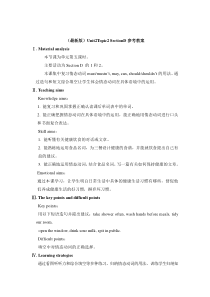 DOC
DOC
【文档说明】Unit 2 Topic 2《I must ask him to give up smoking》(SectionD)教案-八年级上册英语【仁爱版】.doc,共(8)页,39.500 KB,由小喜鸽上传
转载请保留链接:https://www.ichengzhen.cn/view-104243.html
以下为本文档部分文字说明:
(最新版)Unit2Topic2SectionD参考教案Ⅰ.Materialanalysis本节课为单元第五课时。主要活动为SectionD的1和2。本课集中复习情态动词must/mustn’t,may,can,should/shouldn’t的用法。通过造句和短文综合填空让学生体会情态动词
在具体语境中的运用。Ⅱ.TeachingaimsKnowledgeaims:1.能复习和巩固掌握正确认读课后单词表中的单词。2.能正确把握情态动词在具体语境中的运用,能正确地用情态动词进行口头和书面复合表达。Skillaims:1.能听懂有关健康饮食的对话或文章。2.能熟练地运用
食品名词,为三餐设计健康的食谱,并能就饮食提出自己有益的建议。3.能正确地运用情态动词,结合食品名词,写一篇有关如何保持健康的文章。Emotionalaims:通过本课学习,让学生明白日常生活中具体的健康生活习惯有哪些,督促他们养成健康生活的好习惯,摒弃坏习惯。Ⅲ.Thekey
pointsanddifficultpointsKeypoints:用以下短语造句并提出建议:takeshoweroften,washhandsbeforemeals,tidyourroom,openthewindow,drinksourmilk,spitinpublic.Difficultp
oints:填空中对情态动词的正确选择。Ⅳ.Learningstrategies通过看图听听力和综合填空等多种练习,归纳情态动词的用法。训练学生归纳知识的能力。Ⅴ.TeachingaidsComputermultimed
iaprojectorEverydaysaying:Alittlesparkkindlesagreatfire.星星之火可以燎原。Ⅵ.TeachingproceduresStepInteractionpatternStuden
tactivityTeacheractivity1.Thewholeclasswork2.Thewholeclasswork1.Focustheirattentionontheteacher.2.Readthesayingaloud.1.Greets
tudentsreadyforlearning.2.Showeverydaysayingforthestudents.(onesayingaweek)Introduction(10minutes)3.Thewholeclasswork4.Groupwork5.Thewhol
eclasswork6.Thewholeclasswork3.Allthestudentsreadtheirhomeworkingroups,preparingforthereport.4.Thechosengroupswi
llreporttheirpassages.5.Studentscorrecttheirpassagesandwritethemontheblackboard.6.Allthestudentsreadaloud.3
.Askthewholeclasstoprepareforthereport:Myeatinghabit.4.Teachercastslotstofindtwogroupstoreport.5.Teacherasksthetwogroupstowritetheirpassagesonthe
blackboard.Teachercorrectsthemifnecessary.6.TeacheroffersfiveorsixminutesforthestudentstoreadthroughSectionA-C.Presentation(8minutes)1.Thewhole
classwork2.Thewholeclasswork3.Thewholeclasswork4.Thewholeclasswork5.Thewholeclasswork6.Thewholeclasswork7.Somestudents
’work1.Studentsdiscussingroups.2.Studentsreadthecorrectsentences.3.Studentsmaythinkofthefollowingphra
ses:washhands,spitonthestreet,tidytheroom,putlitterintothedustbin,openthewindow.4.Studentslistenandnumberthepictures.5.Studentswritedowna
phraseundereachpicture.6.Studentschecktheiranswers.7.Volunteerswillreadtheiranswers.1.TeacherasksthestudentstocheckGramm
arandFunctionsingroups.2.Teacherasksthestudentstocorrectthewrongparts.3.Teacherletsthestudentstolookthrough1andsayaphrasecorrespondingtoeachpictu
re.4.Teacherplaystherecordingof1.5.Teacherplaysagainandpauseswhennecessary.6.Teacherplaysforthethirdtime.7.Teacherchecks
thestudents’answersto1.Consolidation(10minutes)1.Thewholeclasswork2.Thewholeclassworkandgroupwork3.Somestudents’work4.Thew
holeclasswork1.Studentsmakesentencesorally,usingthefollowingphrases:takeshoweroftenwashhandsbeforemealsspitinpublicdrinkyoghurttidyourroomo
penthewindowkeeptheairfresh2.Studentsineachgroupsaythesentencesinturn,witheachsayingone.Sixgroupsstartatthesame
time.3.Eachstudentinthefirstgroupwillsayonesentenceclearly.4.Studentsguessthefunctionbywhattheteachersays
.1.Teacherasksthestudentstomakesentencesaccordingto1.2.Teacherorganizesacompetitiontoseewhichgroupmakesentencesthemostfluently.3.Teac
herasksthebestgrouptosaythesentencesclearly.4.Teachersumsupthefunctionof“should/shouldn’t…must/mustn’
t…”.TeachermayexplainitinChinese.Practice(10minutes)1.Thewholeclasswork2.Thewholeclasswork3.Thewholeclasswork4.Thewholeclasswork5.Thewholeclasswor
k6.Somestudents’work7.Somestudents’work8.Thewholeclasswork1.Studentsreadthephoneticsyllablesandunderstandthemeaning,answeringthequestions.
2.Studentsgettorealizewhattheteachersays.3.Studentsunderstandtheword“disease”byunderstandingsynonymous“illness”.4.Studentsunderstand“harm”byundersta
nding“bebadfor”.5.Studentsreadsilentlyandtrytofinish2.6.Studentsmayaskforhelpiftheydon’tunderstandwell.7.Volunteerswritetheirans
wersontheblackboard.8.Studentstrytounderstand.1.Teachershowsapictureofcigarettewithphoneticsyllablesandasksquestions:Doyousmoke?Wh
osmokesaroundyou?2.Teachergoeson.Smokingisbadforourbody.Bodyheremeanshealth,pointingtomybodyandyourbody.3.Teacherexp
lains.Smokingcancauseillness.Smokingcancausedisease.4.Teachergoeson.Smokingharmsourbodywhilehere“harm”means“b
ebadfor”.5.Teachersumsup.Smokingisbadforourhealth.Smokingharmssmokersandus.(Teacheractsagestureofsmoking.)Itcancausedisease.Let’s
read2aboutsmoking.6.Teacherexplains“chemicals”bypointingthesmokeandfogaroundacigaretteonscreen.7.Teacherasksthreestudentstoshowtheirans
wersontheblackboardandcorrectsthem.8.Teacherexplainsthefunctionof“can”,whichreferstopossibility.Production(7minutes)1.Thewholeclas
swork2.Groupwork3.Thewholeclasswork1.Studentsfinishitaccordingtothefact.2.Studentsdiscussingroups3.Studentsdothefollowingjobs:
(1)Studentswriteashortpassage“Howtokeephealthy”afterclass,preparingforheperformancenextclass.(2)StudentspreviewthevocabularyandthedialogueinSe
ctionA,Topic3.1.Teacherletsthestudentsfinishtestinginprojection.2.Teacherasksthestudentstodiscusswhoisth
ehealthiestinyourgroup.3.Teacherassignshomework:(1)Teacherasksthestudentstowriteashortpassage“Howtokeephealthy”.(2)PreviewSecti
onA,Topic3.TeachingReflectionIt’salittledifficultforthestudentstomakesentences,buttheyareinterestedinit.Themostdifficultistouse“can,should/
shouldn’t,must/mustn’t”incorrectsituation.Ⅶ.BlackboarddesignUnit2KeepingHealthyTopic2Imustaskhimtogiveupsmoking.Sect
ionDWeshould/shouldn’t…Wemust/mustn’t…Don’tspitinpublic.Tidyourroom.takeshoweroftenwashhandsbeforemealsspitinpublicdrinkyo
ghurttidyourroomopenthewindowkeeptheairfresh
 辽公网安备 21102102000191号
辽公网安备 21102102000191号
 营业执照
营业执照